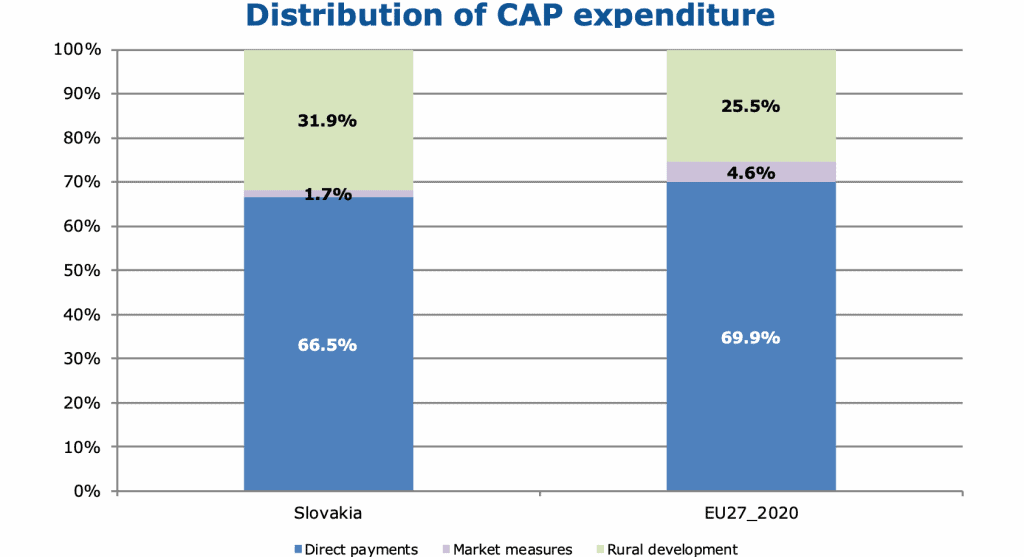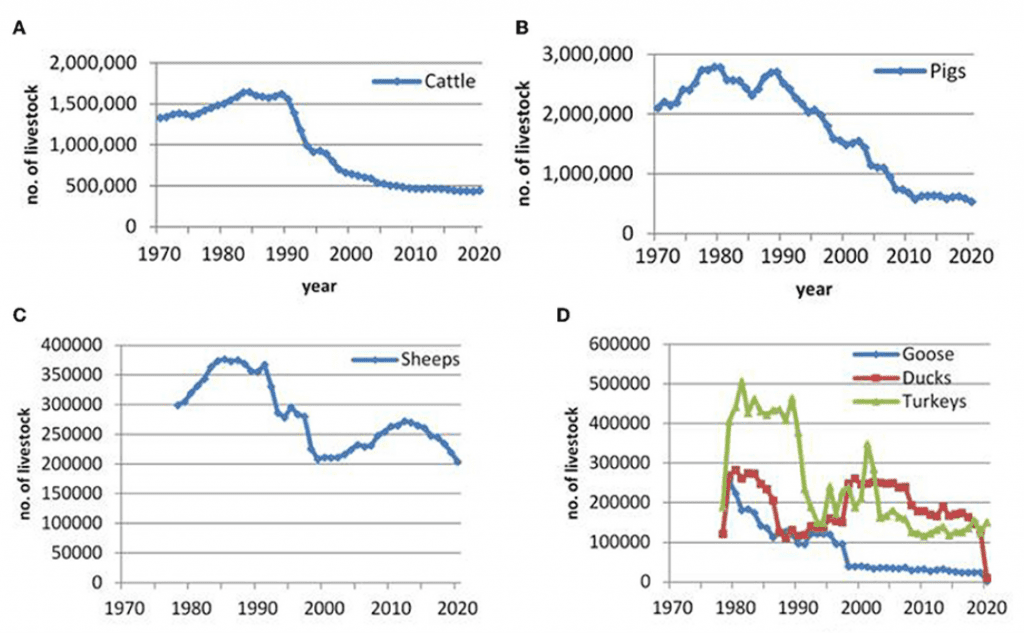3.6 percent of Slovakia’s GDP and 3.9 percent of its labor force were devoted to agriculture in 2016. Large farm holdings are a defining feature of the agricultural industry; Slovakia’s average farm size is 77.5 hectares, compared to the EU average of 14.4 ha. Slovakia has agricultural land covering more than 40% of the country. Sugar beets, potatoes, wheat, barley, fruit, forest products, corn, pigs, cattle, poultry, and sheep are the main agricultural products. Malting and beer production are two additional significant agricultural industries in Slovakia.
The lack of young people who are interested in farming is the primary obstacle facing the nation’s agriculture. Investments are also lacking in the R&D sector. Slovakia has one of the lowest budgets for science in Europe, spending only about 0.7% of its GDP on research and development. Slovakia’s agri-food industry requires fundamental assistance and financial incentives to encourage farmers to stay in business through improving agricultural eco-systems.
The Agricultural Market In Slovenia – What Makes It An Agriculturally Rich Nation?
In terms of landscape diversity and stability, the peasantry era, which is characterized by small-scale comprehensive management and the production of mosaic landscape structures, produced the most valuable landscape structures.
The cultivation of grapes and the making of wine are the dominant activities in vine-growing areas. Slovakia’s vinifera regions serve as the vast southern-central European vine region’s northern border. Regardless of relief, vines are grown on the warmest slopes. The earliest records date vine cultivation to the seventh and eighth centuries BC. Between 1990 and 2021, the total area of vines decreased by 24.1%, while wine output decreased by roughly 40%. Small-block traditional vines are particularly vulnerable. Traditional vineyards were significantly impacted by the collectivization and intensification of agriculture since many small-block vineyards were replaced with large-block vineyards, frequently with extensive terraces, which were technically simpler to cultivate.
Because traditional meadow-pasture landscapes were not significantly impacted by human activity in the preceding century, their classic Wallachian colonial character has been retained, typically in remote or inaccessible locations with little to no infrastructure. As these ancient agricultural landscapes currently only cover a small area and are continually threatened by human activity, more consideration must be given to them. The most prevalent type of traditional agricultural landscape (covering 6.3 percent of Slovakia’s territory) is one with dispersed communities, followed by meadow-pasture landscape (5 percent) and wine-growing landscape (which makes up less than 1% of Slovakia’s land).

The Agricultural Market in Slovakia – When The Agricultural Sector Started To Resemble What It Is Now
the era of democracy that followed the Velvet Revolution, during which a market economy was successfully transitioned from a government-run one. The shift from a centralized to a market economy had both benefits and drawbacks. Slovak farmers’ ability to compete was hampered by the collapse of old markets, an underdeveloped land market, and a faster increase in input prices than output prices in agriculture. As a result, the cooperatives that had been quite effective and successful in the past started to fall apart. Due to its high labor requirements and inability to compete with items imported from other countries, the livestock industry started to fall initially.

Since 1990, numerous reforms have impacted Slovak agriculture, and Slovakia’s accession to the EU entailed adopting commitments in the area of environmental regulation. Ecological and environmental constraints were followed, resulting in a decrease in the use of chemicals and machines and, as a result, a less burden on the various landscape elements. The number of industrial fertilizers used in agriculture was significantly reduced as intensification went down. Pesticide use peaked in 1980 at 19,016 tons, but by 1993 it had dropped to 3,904.5 tons, a 79.5 percent decrease.
Since agricultural cooperatives were often the only source of income and employment in rural areas, the collapse of agricultural holdings significantly harmed the economic foundation of many rural communities. With the revolutionary changes came a gradual resolution of property disputes. The land was given back to its original owners, many of whom were no longer interested in farming it or had the necessary technical, financial, or human resources. The expansion of forestland was a result of some of the less productive and difficult-to-access land remaining uncultivated and abandoned.
The alteration in the structure of cultivated crops was another indication of the open market. Slovak farmers’ ability to compete in the market was hampered by the loss of conventional markets, an underdeveloped land trade, and input prices rising faster than output prices. Crop structures started to diversify, with an emphasis on those that were profitable in the market. In addition to grains, energy crops including sunflower, corn, rapeseed, and others are now primarily grown. Energy cropland has expanded by over 200 percent. Compared to 1990, the cereal area slightly dropped by 5%. The cultivation of potatoes, sugar beet, and fodder showed the greatest reduction. Energy crops can pose a threat to individual landscape elements as well as to natural ecosystems if they are grown without proper regulation. Large-scale arable land continues to dominate the landscape structure, although its use has evolved to meet market values for different crops.
The Agricultural Market In Slovakia – How It Is In the Present Moment
Slovakia imported 5.35 billion USD worth of food, seafood, and forestry products in 2018 while exporting 3.33 billion USD. The Czech Republic, Poland, and Germany are Slovakia’s top trading partners in the agriculture sector.
Slovakia imported food and agricultural products from the United States totaling USD 11.3 million in 2018, an increase of 10% from USD 10.3 million in 2017. Official import data excludes sizeable and expanding transshipments of American goods from other EU nations.
The most promising agricultural exports from the United States include consumer goods including fish and seafood, distilled spirits, and tree nuts, particularly almonds. The food processing industry is the main user of American food preparations. The present administration works to achieve GMO-free food country designation and a new national food labeling system with the help of NGOs.

Greening initiatives and support for organic farming, which is considerably more attentive to nature protection, natural resources, and the environment, are now receiving increasing attention. Organic farming showed a favorable trend over the long term (1993-2020), increasing by 11.45 percent. One of the primary objectives of the Environmental Strategy 2030 of the SR in the field of sustainable land management is to increase the share of organic farming to at least 13.5 percent by 2030. The European Commission’s Farm to Fork strategy outlines the organization’s objectives for transforming the EU food system to one that is healthier and more sustainable. By 2030, 25% of all farmland should be used for organic farming.
Bibliography:
- Zita Izakovičová, Jana Špulerová, and Andrej Raniak, ‘The Development of the Slovak Agricultural Landscape in a Changing World’ 25 May 2022, Sec.Agroecology and Ecosystem Services.
- “Slovakia – Agricultural Sectors” – https://www.privacyshield.gov/article?id=Slovakia-Agricultural-Sectors
- Statistical Factsheet – Slovakia – June 2021 – https://ec.europa.eu/info/sites/default/files/food-farming-fisheries/farming/documents/agri-statistical-factsheet-sk_en.pdf





